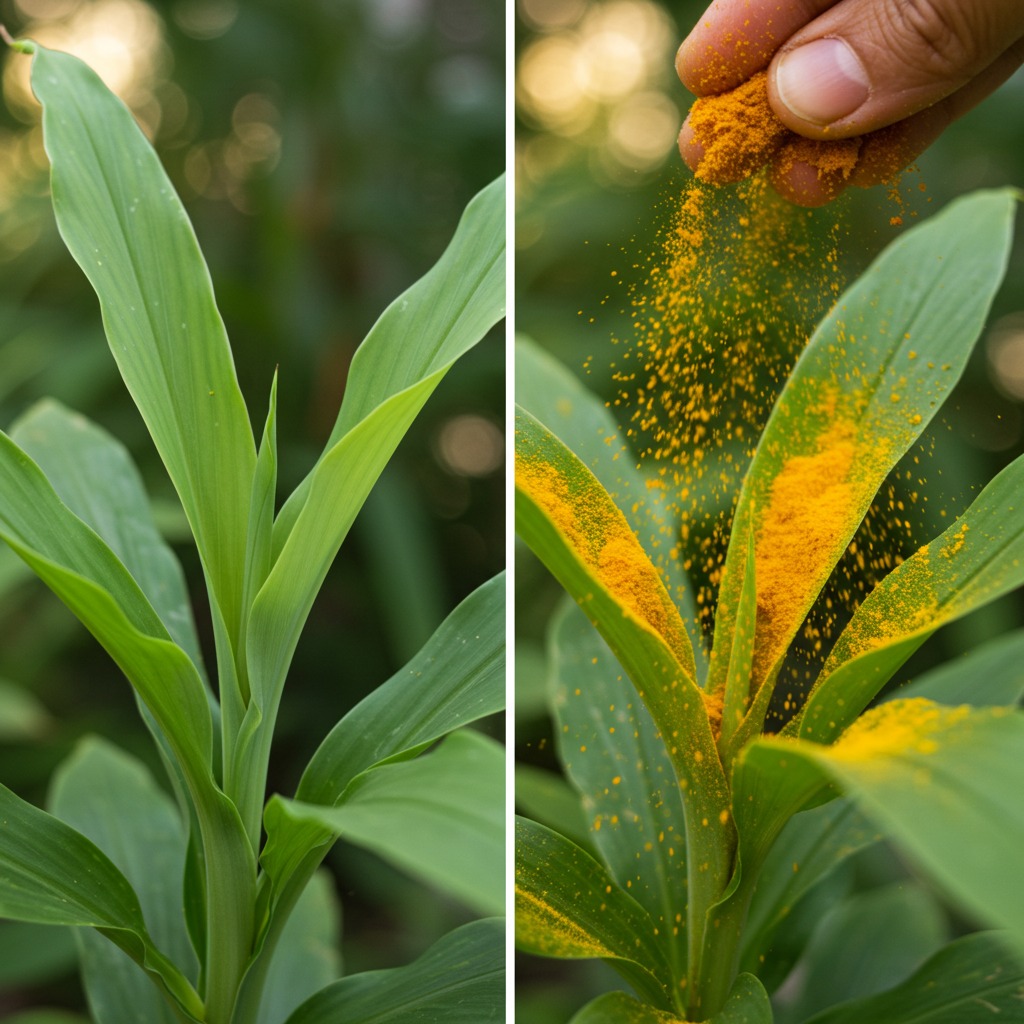Turmeric—long celebrated as a golden treasure in the kitchen—has quietly gained an incredible reputation among gardeners as a powerful, all-natural remedy for plant care. Known scientifically as Curcuma longa, this vibrant yellow spice isn’t just for adding flavor and color to your meals. It’s also a potent antibacterial, antifungal, insect-repelling, and healing agent. In the garden, turmeric offers a sustainable and non-toxic solution to many common problems, making it a gardener’s secret weapon.
Today, I’ll share 10 surprising and effective ways you can use turmeric in your garden to nourish, protect, and heal your plants. From repelling pests to preventing root rot and promoting healthy growth, turmeric’s versatility in garden care is remarkable.
Let’s dive deeper into these turmeric-powered gardening hacks and how to use them effectively.
1. Powerful Natural Ant Repellent
Ants are more than a minor nuisance in the garden—they often encourage other pests like aphids and mealybugs. Turmeric’s strong scent interferes with the ants’ scent-trailing ability, disrupting their movement and communication.
How to Use:
Sprinkle turmeric powder in a thin line around your plants, garden beds, or even on anthills. The ants will avoid crossing it. Use this method sparingly; too much can affect soil balance.
Bonus Tip: If you’re dealing with a specific ant path, trace the entire trail with turmeric powder to deter them completely.
2. Repels Mealybugs
Mealybugs, those cottony-looking pests, often thrive thanks to ants that “farm” them for the sugary honeydew they produce. By driving away ants, you also remove a key protector of mealybugs—leaving them vulnerable.
How to Use:
Sprinkle turmeric near affected plants. You can also dust it lightly on leaves, but be careful not to over-apply, especially during hot weather, as it may block pores on the leaf surface.
3. Natural Pesticide for Garden Pests
Turmeric contains compounds that repel a variety of common garden pests, including cabbage loopers, grey worms, and other larval insects. It also deters certain beetles and slugs when used regularly.
How to Use:
Dust turmeric powder at the base of susceptible plants or directly on pest-prone areas. Reapply after rain or heavy watering.
For added effect: Mix turmeric with neem powder for a broader-spectrum natural pesticide.
4. Effective Antifungal Spray
Turmeric’s strong antifungal properties make it an excellent treatment for fungal diseases, such as damping off, rust, or mildew. It works by disrupting fungal spores and inhibiting their growth.
How to Use:
Mix 2 teaspoons of turmeric powder in 1 liter of water. Stir well and pour the mixture into a spray bottle. Spray on infected areas in the early morning or late evening. Avoid applying under strong sunlight to prevent leaf burn.
Repeat every few days until the infection clears up.
5. Treats Leaf Spots Naturally
Dark or black spots on leaves can be caused by fungal or bacterial infections. Turmeric spray acts as a disinfectant and promotes faster healing.
How to Use:
Mix turmeric powder with water in the same proportions as above and apply to affected leaves. Make sure to coat both the top and underside of the leaves. Remove severely damaged foliage to prevent spread.
6. Fights Powdery Mildew with Natural Ingredients
Powdery mildew is a common garden problem that affects roses, cucumbers, and squash. Turmeric can be used in combination with other kitchen ingredients for maximum effect.
How to Use:
Mix:
- 2 teaspoons of turmeric powder
- 100 ml of milk
- 2 teaspoons of white vinegar
- 1 liter of water
Spray on infected plants every 3 days until the mildew is under control. This blend creates a mild acidic and antibacterial solution that breaks down mildew spores effectively.
7. Prevents Dieback in Rose Bushes
Rose dieback often starts at pruning sites, especially when left unsealed and exposed to pathogens. Turmeric acts as a natural antiseptic and sealant.
How to Use:
After pruning, make a thick paste of turmeric and water. Apply directly to the cut ends of stems or branches. It will act as a protective layer, much like a plant “band-aid.”
You can also mix turmeric with a bit of cinnamon powder for added antifungal strength.
8. Prevents Root Rot in Potted and Ground Plants
Root rot is caused by overwatering and fungal infections in the soil. Turmeric helps prevent this by balancing soil microbes and eliminating harmful fungi before they take over.
How to Use:
- For potted plants: Mix 1 tablespoon of turmeric into every 5 liters of potting mix.
- For in-ground plants: Dissolve 1 teaspoon of turmeric in 1 liter of water and use it to water the base of the plant once a week.
Caution: Turmeric is slightly acidic, so avoid overuse with acid-sensitive plants.
9. Heals Plant Wounds
Just like it helps with human wounds, turmeric promotes healing in plants after physical damage caused by pruning, pests, or wind.
How to Use:
Mix turmeric with a small amount of clean water to make a thick paste. Apply it to the wound and cover with grafting tape or a clean cloth to keep the paste in place. Over a few days, the turmeric will act as an antiseptic, preventing infection and promoting callus formation.
10. Promotes Root Development in Cuttings
Turmeric stimulates root growth, making it a viable alternative to commercial rooting hormones. It also protects new cuttings from fungal infections and bacteria during the vulnerable rooting phase.
How to Use:
Dip the cut end of a stem cutting in dry turmeric powder before planting in moist potting mix.
Or, mix 1 tablespoon of turmeric with the soil before planting cuttings.
This not only promotes faster root development but also strengthens the young plant’s natural defenses.
Why Choose Turmeric Over Chemicals?
Chemical pesticides, fungicides, and fertilizers often contain harmful ingredients that can pollute soil, water, and even impact pollinators like bees. In contrast, turmeric is:
- Biodegradable
- Non-toxic
- Safe for pets and children
- Affordable and easy to find
- Effective in small quantities
In addition, using turmeric supports a more holistic and organic approach to gardening, allowing your plants to thrive without depending on synthetic solutions.
How to Store and Use Turmeric for Gardening
- Storage: Keep turmeric powder in an airtight container away from moisture and sunlight.
- Shelf Life: Turmeric can last for months when stored properly.
- Application Tools: Use a fine mesh shaker or a repurposed spice container to dust powder precisely. For liquid solutions, a spray bottle with fine misting capability works best.
Important Tip: Always test turmeric treatments on a small section of a plant first. While it’s generally safe, some sensitive plants may react to natural acids or essential oils present in turmeric.
A Final Word: Let Turmeric Be Your Garden’s Best Friend
Turmeric proves that sometimes the best solutions are already in your kitchen. With its broad-spectrum abilities to repel pests, heal wounds, prevent disease, and promote healthy growth, turmeric stands out as a must-have in every gardener’s toolkit.
Whether you’re tending to houseplants on a balcony or managing a full-scale garden, turmeric is an easy, natural, and eco-friendly way to keep your green space thriving. So next time you reach for the spice rack, consider sharing some of that golden goodness with your plants—and watch the magic happen.
Would you like a printable guide or infographic version of these turmeric uses for your garden? I’d be happy to make one! 🌿





